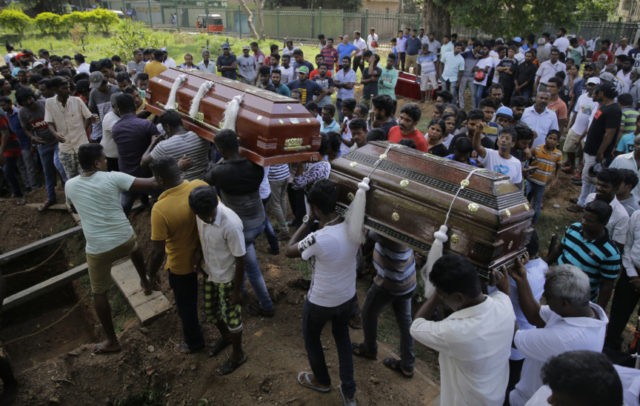Some good news emerged from Sri Lanka for the grimmest of reasons on Friday, as the government revised the official death toll down from 359 to 253. Officials explained the precise number of dead is difficult to ascertain because the bodies of victims were mangled so horribly by the explosions.
“Some of the bodies get severely damaged in these kinds of explosions and it’s possible for some bodies to get completely destroyed or break into parts, making the identification of full bodies difficult. Hence, counting an exact death toll is challenging,” the Sri Lankan health ministry said on Friday.
George Washington University Professor Victor Weedn, an expert in forensic pathology, described the situation to the Washington Post in blunt terms:
Recovering three right index fingers, for example, could indicate that three people were killed. But if left fingers are also recovered, they could belong to the same individuals as the right fingers. Similarly, two recovered legs and one human trunk could initially seem to indicate three bodies, Weedn said, and turn out to be only one. This kind of miscounting can easily inflate a death toll.
And depending on the type of attack, the fragmentation of human remains can make collection and counting even more complicated.
“You may have hundreds of pieces of one person,” Weedn said. That makes it difficult to identify them and difficult to know what to collect from the scene where they died. “How about something as big as your finger … what about a grass blade with blood on it? It’s a slippery slope — you don’t know where to start and stop.”
Another expert, Joe Hefner of Michigan State University, noted the chaotic security situation in the aftermath of the bombing would hinder investigators and said the sheer scale of the carnage would overwhelm even the advanced police and medical resources of an American city.
He added that the lack of a solid list of potential victims, as would be the case with the passenger manifest of an airplane crash, makes it difficult to determine exactly how many people are missing. Collecting and screening individual missing persons reports by telephone is a slow and painstaking process by the standards of modern media, made even slower because Sri Lankan authorities blocked access to many popular social media services after the bombings.
Even reducing the death toll by 100 does not mitigate the devastating impact of the bombing on the people of Sri Lanka. Grieving survivors have spoken of losing entire generations of their families. Wives and children are struggling to survive without husbands and fathers. Families, businesses, and governments around the world are reeling from the loss of people killed while visiting Sri Lanka.
Sri Lankan Prime Minister Ranil Wickremesinghe dug in on Friday and refused to resign, insisting intelligence officials are to blame for not passing warnings of the impending attack along to his office.
“If we had any inkling, and we had not taken action, I would have handed in my resignation immediately. But what do you do when you are out of the loop?” he said.
Sri Lankan police acted aggressively to roll up the terrorist cells responsible for the attack, pursuing over 140 suspects and making 70 arrests. A raid on Friday turned into a fierce gun battle, with several explosions heard by witnesses. Police reported recovering explosives, Islamic State uniforms and flags, and a hundred thousand ball bearings intended to be used as shrapnel from another raid.
Writing at the Hill on Friday, A.J. Caschetta of the Middle East Forum said the Easter Sunday atrocity was a sign the Middle East has come to Sri Lanka, arriving via a “nexus of illegal drugs, arms, and jihadist ideology.”
The Islamic State appears to have been the conduit for jihad ideology and bomb-making expertise. Caschetta said the importance of the drug trade should not be overlooked:
In the South Columbo region of Dehiwala, where Sri Lanka’s largest concentration of Muslims resides, a major drug trafficker named Dawood Ibrahim Kaskar reportedly has set up a distribution hub that has brought record-breaking quantities of heroin into the country. Dawood, as he is commonly called, was designated by the U.S. Department of Treasury a terrorist supporter in 2003.
In 2018, authorities seized 736 kilograms of Dawood’s heroin, according to Sri Lankan police. Writing in The Afternoon Voice, Salah Uddin Shoaib Choudhury describes Dawood’s D-Company cartel beginning with opium produced in Afghanistan, overseen by the Taliban. From there, logistics and transportation are arranged through Pakistan’s Inter-Service Intelligence (ISI), which protects Dawood’s home base in the city of Karachi.
Distribution of the drugs throughout the “Golden Horseshoe Caliphate” nations (Indonesia, Singapore, Malaysia, Thailand, Myanmar, Bangladesh, India and Sri Lanka) is accomplished through consignment, including Islamic gangs that “have become so powerful in Sri Lanka that they are creating an underground army,” according to Choudhury. A portion of the profits are distributed, per ISI orders, to jihadists groups such as al Qaeda, ISIS, Lashkar-e-Taiba, Jamaat-e-Islami and others.
Sri Lankan President Maithripala Sirisena on Friday addressed one of the lingering questions about the Easter Sunday attacks by stating alleged mastermind Zahran Hashim was one of the suicide bombers and died while attacking the Shangri-La hotel in the capital city of Colombo.

COMMENTS
Please let us know if you're having issues with commenting.